
The Pallava dynasty existed from 275 CE to 897 CE, ruling a significant portion of the Deccan, also known as Tondaimandalam. The Pallavas played a crucial role in shaping in particular southern Indian history and heritage. The dynasty rose to prominence after the downfall of the Satavahana Empire, whom they had formerly served as feudatories.

Simhavishnu also known as Avanisimha son of Simhavarman III and one of the Pallava kings of India, was responsible for the revival of the Pallavan dynasty. He was the first Pallava monarch whose domain extended beyond Kanchipuram (Kanchi) in the South. He was portrayed as a great conqueror in Mattavilasa Prahasana, a drama written by his son Mahendravarman I.

Vikramaditya II was the son of King Vijayaditya and ascended the Badami Chalukya throne following the death of his father. This information comes from the Lakshmeshwar inscriptions in Kannada dated 13 January 735 A.D. From inscriptions it has come to be known that even before his coronation, Vikramaditya II, as a crown prince (Yuvaraja), had conducted successful military campaigns against their arch enemy, the Pallavas of Kanchipuram. His most important achievements were the capture of Kanchipuram on three occasions, the first time as a crown prince, the second time as an emperor and the third time under the leadership of his son and crown prince Kirtivarman II. This is attested to by another Kannada inscription, known as the Virupaksha Temple inscription which alludes to the emperor as the conqueror of Kanchi on three occasions and reads Sri Vikramaditya-bhatarar-mume-Kanchiyan-mume parajisidor. The other notable achievement was the consecration of the famous Virupaksha Temple and Mallikarjuna Temple by his queens Lokadevi and Trilokadevi at Pattadakal. These two monuments are the centre piece of the UNESCO World Heritage Monuments at Pattadakal. Vikramaditya II was a powerful ruler and was in power for 40 years. In order to maintain peace he entered into marriage alliance with Rashtrakutas.
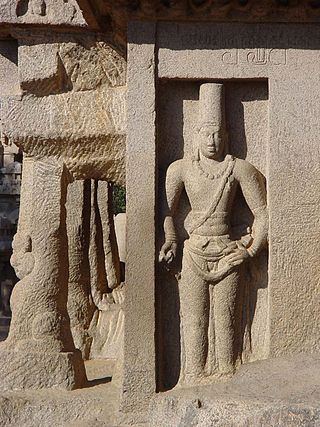
Narasimhavarman I was a Pallava emperor who reigned from 630 CE to 668 CE. He shared his father Mahendravarman I's love of art and completed the works started by Mahendravarman in Mamallapuram. During his reign, the famous Pancha Rathas, a monolithic rock-cut temple complex and a UNESCO World Heritage Site was constructed.
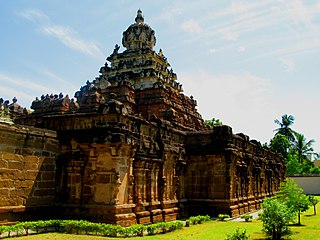
Kanchipuram also known as Kanjeevaram, is a city in the Indian state of Tamil Nadu in the Tondaimandalam region, 72 km (45 mi) from Chennai – the capital of Tamil Nadu. Known as the City of Thousand Temples, Kanchipuram is known for its temple architectures, 1000-pillared halls, huge temple towers and silk saris. Kanchipuram serves as one of the most important tourist destinations in India. Kanchipuram has become a centre of attraction for foreign tourists as well. The city covers an area of 36.14 km2 (13.95 sq mi) and an estimated population of more than 300,000 in 2021. It is the administrative headquarters of Kanchipuram District. Kanchipuram is well-connected by road and rail.

The Kailasanathar Temple, Kanchipuram, also referred to as the Kailasanatha temple, is a Pallava-era historic Hindu temple in Kanchipuram, Tamil Nadu, India. Dedicated to Shiva, it is one of the oldest surviving monuments in Kanchipuram. It reflects a Dravidian architecture and was built about 700 CE by Narasimhavarman II with additions by Mahendravarman III. A square-plan temple, it has a mukha-mandapa, a maha-mandapa and a primary garbha-griya (sanctum) topped with a four-storey vimana. The main sanctum is surrounded by nine shrines, seven outside and two inside flanking the entrance of the sanctum, all with forms of Shiva. The outer walls of the temple's prakara (courtyard) is also surrounded by cells.
Pulakeshin II popularly known as Immaḍi Pulakeśi, was the greatest Chalukyan Emperor who reigned from Vatapi. During his reign, the Chalukya Empire expanded to cover most of the Deccan region in peninsular India.
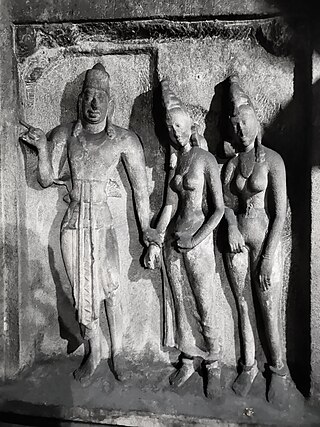
Mahendravarman I was a Pallava emperor who ruled the Southern portion of present-day Andhra region and Northern regions of what forms present-day Tamil Nadu in India in the early 7th century. He was a scholar, painter, architect, musician. He was the son of Simhavishnu, who defeated the Kalabhras and re-established the Pallava kingdom.
Vikramaditya I was the third son and followed his father, Pulakeshi II on to the Chalukya throne. He restored order in the fractured empire and made the Pallavas retreat from the capital Vatapi.
Kadava was the name of a Tamil ruling dynasty who ruled parts of the Tamil country during the thirteenth and the fourteenth century. Kadavas were related to the Pallava dynasty and ruled from Kudalur near Cuddalore in Tamil Nadu. Hiranyavarman, the father of Nandivarman II Pallavamalla is said to have belonged to the Kadavakula in epigraphs. Nandivarman II himself is described as "one who was born to raise the prestige of the Kadava family". Chiefs bearing the Kadava title figure as feudatories of the Cholas as early as the 12th century. During the reign of Kulothunga Chola II, there was a vassal called Alappirandan Elisaimohan alias Kulottungasola Kadavaradittan. The Kadava kingdom was at the height of their power briefly during the reigns of Kopperunchinga I and Kopperunchinga II. These two rulers were powerful enough to challenge the waning Chola dynasty during the reign of Rajaraja Chola III and Rajendra Chola III. The two Kopperunchingas have left a large number of inscriptions mostly in the North and South Arcot districts and in the Chingleput district.
Parameswaravarman I was a Pallava emperor who reigned in southern India in the latter half of the 7th century, 670 - 695 CE. He ascended to the throne after the death of his father Mahendravarman II in 670 CE. His grandfather Narasimhavarman I had already made the Pallava empire the most powerful force in the subcontinent and destroyed the Chalukya capital at Vatapi. Parameswaravarman was an efficient and capable ruler, known for his military exploits, his love for poetry and his devotion to the God Siva, to whom he erected many temples.

Thiru Parameswara Vinnagaram or Vaikunta Perumal Temple is a Hindu temple dedicated to the God Vishnu, located in Kanchipuram in the Southern Indian state of Tamil Nadu. Constructed in the Dravidian style of architecture, the temple is glorified in the Nalayira Divya Prabandham, the early medieval Tamil canon of the Alvar saints from the 6th through the 9th centuries CE. It is one among the 108 Divya Desams dedicated to the God Vishnu, who is worshipped as Vaikuntanathan and his consort, the Goddess Lakshmi as Sri Vaikundavalli. The temple is considered the second oldest extant temple in Kanchipuram after the Kailasanathar temple.
Pusalar is an eighth-century Nayanar saint, venerated in the Hindu sect of Shaivism. He is generally counted as the fifty-eighth in the list of 63 Nayanars. His hagiography speaks how he created a grand temple for Shiva in his mind and how his patron god Shiva preferred attending the consecration of his mind temple, instead of a grand temple created by a Pallava king.

The Battle of Vatapi was a decisive engagement which took place between the Pallavas and Chalukyas near the Chalukya capital of Vatapi in 642. The battle resulted in the defeat of the Chalukya king Pulakeshin II in 642 CE and the commencement of Pallava occupation of Vatapi lasted until 654.
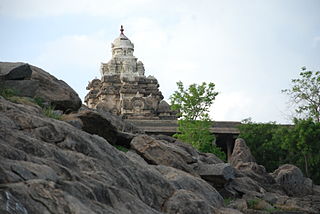
Talagirisvara Temple is a Hindu temple located in the village of Panamalai in the Viluppuram district of Tamil Nadu, India.

Dharmaraja Ratha is a monument in the Pancha Rathas complex at Mahabalipuram, on the Coromandel Coast of the Bay of Bengal, in the Kancheepuram district of the state of Tamil Nadu, India. It is an example of monolith Indian rock-cut architecture. Dating from the late 7th century, it is attributed to the reign of King Mahendravarman I and his son Narasimhavarman I of the Pallava Kingdom. The entire complex is under the auspices of the Archaeological Survey of India (ASI). It is one of the Group of Monuments at Mahabalipuram that were designated as a UNESCO World Heritage Site since 1984.

Ganesha Ratha is a temple in Kancheepuram district, Tamil Nadu, India. It is one of ten rathas ("chariots") carved out of pink granite within the group of monuments of the Pallava Period at Mahabalipuram, a UNESCO-inscribed World Heritage Site since 1984. The ratha is an example of monolith Indian rock-cut architecture dating from the late seventh century during the reign of King Mahendravarman I and his son Narasimhavarman I. Initially constructed with a Shiva Linga, it is now deified with a Ganesha deity after the linga was removed.
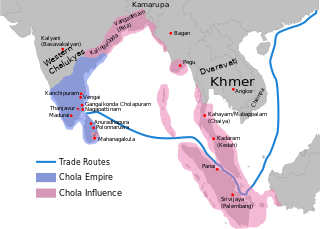
Tamils maintained a good relationship with the Chinese, with evidence of trade relations going back to 2nd century BC.
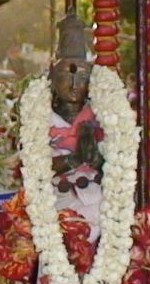
Kalarsinga Nayanar, also known as Kalarsinga, Kazharsinga, Kalarcinkan, Kalarsingan, Kalarsinganar, Kalarsingar, Kalarcingar and Kalar-chingar (Kalar-singar), was a Nayanar saint, venerated in the Hindu sect of Shaivism. He is generally counted as the fifty-fifth in the list of 63 Nayanars. While his identity remains a matter of debate, many scholars identity Kalarsinga Nayanar as the Pallava king Narasimhavarman II (Rajasimha), who reigned between 700 and 728 CE.

Pallava art and architecture represent an early stage of Dravidian art and architecture which blossomed to its fullest extent under the Chola Dynasty. The first stone and mortar temples of South India were constructed during Pallava rule and were based on earlier brick and timber prototypes.
















